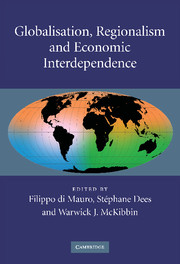Book contents
- Frontmatter
- Contents
- List of figures
- List of tables
- List of contributors
- Preface
- Introduction
- 1 International linkages in the context of global and regional integration
- 2 Trade integration of the central and eastern European countries and China: has it reached potential?
- 3 Patterns and determinants of production fragmentation in world manufacturing trade
- 4 Going global: trade, internationalisation of production and domestic performance of euro area firms
- 5 Globalisation and the trade channel in the euro area
- 6 Gauging the labour market effects of international trade openness: an application to the US manufacturing sector
- Index
- References
3 - Patterns and determinants of production fragmentation in world manufacturing trade
Published online by Cambridge University Press: 02 September 2009
- Frontmatter
- Contents
- List of figures
- List of tables
- List of contributors
- Preface
- Introduction
- 1 International linkages in the context of global and regional integration
- 2 Trade integration of the central and eastern European countries and China: has it reached potential?
- 3 Patterns and determinants of production fragmentation in world manufacturing trade
- 4 Going global: trade, internationalisation of production and domestic performance of euro area firms
- 5 Globalisation and the trade channel in the euro area
- 6 Gauging the labour market effects of international trade openness: an application to the US manufacturing sector
- Index
- References
Summary
Introduction
International production fragmentation – the geographic separation of activities involved in producing a good (or service) across two or more countries – has been an important feature of the deepening structural interdependence of the world economy in recent decades. After a modest start in electronics and clothing industries in the late 1960s, international production networks have gradually evolved and spread into many industries, such as sport footwear, automobiles, televisions and radio receivers, sewing machines, office equipment, electrical machinery, power and machine tools, cameras and watches. At the formative stage, outsourcing predominantly involved locating small fragments of the production process in a low-cost country and reimporting the assembled components to be incorporated in the final product. Over time, production networks have begun to encompass many countries, resulting in multiple border crossings on the part of unfinished parts before the completion of the final product.
In the early stages of the international fragmentation of production, the processes normally involved a multinational enterprise (MNE) building a subsidiary abroad to perform some of the functions that it once did at home (Helleiner, 1973). Over the years, MNE subsidiaries have begun to subcontract some activities to local (host-country) firms, to which they provide detailed specifications and even fragments of their own technology.
- Type
- Chapter
- Information
- Globalisation, Regionalism and Economic Interdependence , pp. 45 - 72Publisher: Cambridge University PressPrint publication year: 2009
References
- 6
- Cited by



